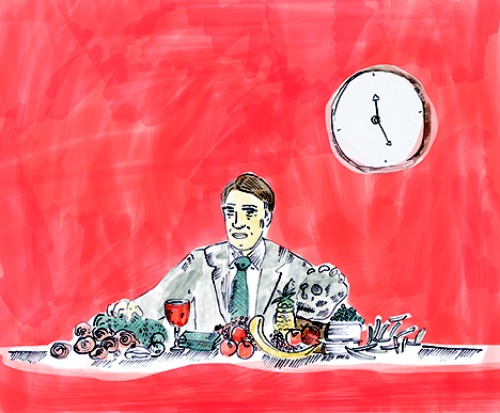 Illustration by Carolyn Figel.
Illustration by Carolyn Figel.
Mutton Dressed as Lamb
John Semley pulls back the skin of Hannibal, a show that prized mouthwatering aesthetics over meaty writing.
LO, THE UNFATHOMABLE DAMAGE the rise of “prestige television” has wrought on our already blasted-out junk heap of a cultural landscape. Lo!
Yes, The Sopranos was a great show. The Wire: also wonderful. Game of Thrones, Breaking Bad and a handful of Mad Men episodes? Yes. Fine. But while watching people watch television and write about it “critically” (i.e., with fan boy glee and rudimentary observational rigour), I’m routinely gripped by those spasms of distrust, skepticism and out-and-out cynicism that give shape and prickly feeling to my annoyance.
Television critics—usually fans who have hitched their professional wagons to an outlet keen to bolster web traffic by publishing rushed-out recaps of incipient enthusiasm—are the primary architects behind the laziest form of modern critical writing, wherein a given cultural object’s meagre charms or modest insights are met with overblown rhapsodies. TV criticism has become an exercise in writers rationalizing and excusing their own dubious taste. (Earlier this year, the AV Club’s Noel Murray actually attempted to critically situate “mid-reputable” television shows including The Flash, which is about a man who can run really, really fast.)
No contemporary show has benefitted from the tendency towards inflated praise more than Hannibal, NBC’s gruesome remake of Thomas Harris’ novels. Roughly following the beats of the book Red Dragon, the show psychoanalyzes the relationship between gifted FBI investigator Will Graham (Hugh Dancy) and cannibalistic forensic psychiatrist Dr. Hannibal Lecter (Mads Mikkelsen). Graham is investigating the disappearance of a handful of young girls in Minnesota. As his mental state deteriorates—his ability to vividly reconstruct crime scenes in his mind leads to plenty of sleepless nights, a classic “my gift is my curse” deal—he finds himself under the psychiatric care of Dr. Lecter, who (spoiler alert) is a killer himself.
It’s not that this sort of psycho-sensationalism doesn’t make good fiction. It does. It did. The Lecter character and the accompanying rookery of FBI hangers-on had been previously milked over the course of four novels and five films. But like caped crusaders and ghost-busting scientists, well-heeled cannibal psychotherapists are now grist for the relentless mill of remaking, reimagining and refranchising.
IN ORDER TO INVEST its reheated premise and characters with something passably novel, show runner Bryan Fuller has cranked up the gore and polished down all the surfaces. Hannibal is, if nothing else, a superficially good-looking show. Obvious, painstaking, showboating care is put into the production, sound design and, especially, the cinematography. “Visually scrumptious” is what Entertainment Weekly called the show’s first season, an example of the sort of laboured culinary puns that are regularly exhausted when writing about Hannibal. This attention to detail—in concert with a few serviceable performances by Dancy, Mikkelsen, Laurence Fishburne and Kid in the Hall Scott Thompson as the FBI’s wise-cracking coroner—invest Hannibal with a certain patina of quality; a veneer of well-tailored prestige that immediately distinguishes the program (at least visually) among a monotonous primetime network TV block.
Particular attention is given to passages of Dr. Lecter preparing his meals. Super-stylized, shot in slow-motion as the good doctor adds oil to glimmering brushed-steel cookware, these scenes seem to doubly capitalize on the grisly foundation of Lecter’s characterization—again, he eats people—along with the ascendancy of so-called “food porn” and the corresponding desire to see food prepared in a way that makes the process of cooking, and not just the result, seem exorbitantly sensuous, if not straight-up sexual. To achieve this, Hannibal employs food stylist Janice Poon. Her blog, Feeding Hannibal, gives insight into the process and role that food plays on the show, written with an unreserved enthusiasm which matches that of Hannibal’s hyperbole-prone fan base. (One photo is captioned, “Brilliant Director David Slade discusses how he will shoot the dinner scene. We’re going for a crane shot! Yay!”)
The food stuff is the only thing I can really stand about Hannibal. The show seemingly stumbles across the idea that not only is eating food vile and repugnant, but that consumption of any kind is inherently disgusting and violent. The attention given to Lecter’s lavish preparation of human corpses and the sickly enjoyment his dinner guests take in savouring them stokes an uncomfortable tension in the viewer (Fishburne especially turns the taken-for-granted act of chewing into its own revolting pornography). We know that the food is “bad”—privy as we are to Lecter’s sourcing of his oh-so-choice cuts—and yet we slobber over it anyway. To live is to consume. And to consume is to destroy. And so we paper over our consumption anxiety with the complicated preparations of our meals and the tasteful appointment of our drawing rooms.
LIKE DR. LECTER, whose upper-crust acculturation seems at once a cover for and product of his deep-rooted psychopathy, we all attempt to forget that we’re gross, barbaric, desperately violent and self-interested creatures by filling our lives up with the stuff that suggests otherwise. The basic premise of the Hannibal Lecter character is, “Well, how can a man who likes the opera be a sociopath?” What Hannibal asks, however ham-handedly and unintentionally, is “how could he not?”
What ultimately rankles about the show is not its gore or violence, but its needling insistence. It insists upon the psychological depth of its stock characters. It’s hell-bent on bludgeoning us over the head with its recurring imagery and wowing with its decadent aesthetic, rich cinematography and swooping crane shots of dinner parties. It demands that we take it seriously, as something other than a trashy primetime cop show. Hannibal assuages the modern TV fan’s own latent consumption anxiety by gussying up its empty calories, like laying a bit of gold leaf over a day-old Timbit.
But again, just like Dr. Lecter, there’s something hollow hanging inside its prestige trappings—the dead-eyed psycho stuffed inside a bespoke three-piece suit.





